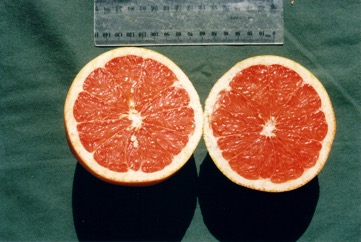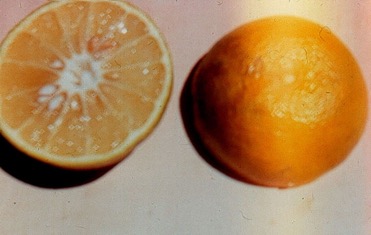Grapefruit

A subtropical plant. Plants grow from sea level up to 1,800 m altitude in the tropics. They are frost tender. Plants prefer well-drained soils and a protected sunny position. Plants are drought tender. They do best in humid climates. It suits hardiness zones 9-11.
Also known as:
Bombelmo, Chakotra, Dat-kywegaw, Kureip-purutu, Kuripa, Lawi hkaw, Lemu yamiku, Pu tao you, Shauk-hka, Shauk-waing, Taraja, Toronja
Synonyms
- Probably now Citrus x aurantium Grapefruit group
- Citrus decumana L. var. racemosa Roem.
- Citrus grandis (L.) Osbeck var. racemosa (Roem.) B. C. Stone
Edible Portion
- Fruit, Herb
Where does Grapefruit grow?
Found in: Africa, Argentina, Asia, Australia, Barbados, Bolivia, Brazil, Cambodia, Cameroon, Caucasus, Central Africa, Central America, China, Cook Islands, Costa Rica, Cuba, East Africa, Ecuador, Europe, Fiji, French Guiana, Georgia, Ghana, Grenada, Guam, Guianas, Guinea-Bissau, Guyana, Haiti, India, Indochina, Indonesia, Israel, Jamaica, Kenya, Laos, Malawi, Malaysia, Marquesas, Mauritius, Mediterranean, Mexico, Morocco, Mozambique, Myanmar, Nicaragua, Nigeria, North Africa, North America, Pacific, Pakistan, Papua New Guinea, PNG, Peru, Philippines, SE Asia, Solomon Islands, Somalia, South Africa, Southern Africa, South America, Spain, Sri Lanka, Suriname, Tanzania, Thailand, Uganda, United Arab Emirates, UAE, United States, Vanuatu, Vietnam, West Africa, West Indies, Zimbabwe
Notes: There are 20 Citrus species. Several hybrids have been formed.
Status: Becoming popular around the world. Not widely grown in Papua New Guinea.
Growing Grapefruit
Cultivation: Plants can be grown from seed. The seed should be sown fresh. Often seedling trees breed true. Trees are best grown by layering or grafting. A spacing of 6-8 m is suitable.
Edible Uses: The fruit is eaten as fresh fruit, or the juice is used in drinks. They are made into marmalade. The juice can be used for vinegar or wine. The peel is candied. The essential oil from the peel is used for flavouring drinks and desserts. The oil from the seed is bleached and refined into a culinary oil. Caution: Grapefruit can react dangerously with some medications, increasing the effect of the medicine.
Production: Seedling trees take 3-5 years to produce while grafted trees take 2-3 years. Fruiting tends to be seasonal from April to August in the Southern hemisphere. Fruit take 6-8 months to mature. A healthy tree can produce 100 fruit in a year. Fruit can be left on the tree for 3 months after they first ripen.
Nutrition Info
per 100g edible portion| Edible Part | Energy (kcal) | Protein (g) | Iron (mg) | Vitamin A (ug) | Vitamin c (mg) | Zinc (mg) | % Water |
|---|---|---|---|---|---|---|---|
| Fruit | 11 | 0.3 | 0.1 | Tr | 19 | 0.1 | 43.5 |
Grapefruit Photos


References
AAK, 1994, Jeruk, Penerbit Kanisius, Jogyakarta. p 202
Abbiw, D.K., 1990, Useful Plants of Ghana. West African uses of wild and cultivated plants. Intermediate Technology Publications and the Royal Botanic Gardens, Kew. p 42
Ambasta, S.P. (Ed.), 2000, The Useful Plants of India. CSIR India. p 129
Bennett, B. C., 1990, Useful Plants of Amazonian Ecuador. US Agency for International Development. Fifth Progress Report. New York Botanical Gardens. p 39
Blamey, M and Grey-Wilson, C., 2005, Wild flowers of the Mediterranean. A & C Black London. p 123
Bodkin, F., 1991, Encyclopedia Botanica. Cornstalk publishing, p 262
Brouk, B., 1975, Plants Consumed by Man. Academic Press, London. p 179
Burkill, H. M., 1985, The useful plants of west tropical Africa, Vol. 4. Kew.
Burkill, I.H., 1966, A Dictionary of the Economic Products of the Malay Peninsula. Ministry of Agriculture and Cooperatives, Kuala Lumpur, Malaysia. Vol 1 (A-H) p 581
Bussman, R. W., et al, 2016, A comparative ethnobotany of Khevsureti, Samtskhe-Javakheti, Tusheti, Svaneti, and Racha-Lechkhumi, Republic of Georgia (Sakartvelo), Caucasus. Journal of Ethnobiology and Ethnomedicine.
Bussman, R. W. et al, 2017, Ethnobotany of Samtskhe-Javakheti, Sakartvelo (Republic of Georgia), Caucasus. Indian Journal of Traditional Knowledge Vol. 16(1) pp 7-24
Cameron, J.W. & Soost, R.K., 1979, Citrus, in Simmonds, N.W., (ed), Crop Plant Evolution. Longmans. London. p 261
Cheifetz, A., (ed), 1999, 500 popular vegetables, herbs, fruits and nuts for Australian Gardeners. Random House p 182
Cobley, L.S. (rev. Steele, W.M.) 2nd Ed., 1976, An Introduction to the Botany of Tropical Crops. Longmans. p 164
Coe, F. G. and Anderson, G. J., 1999, Ethnobotany of the Sumu (Ulwa) of Southeastern Nicaragua and Comparisons with Miskitu Plant Lore. Economic Botany Vol. 53. No. 4. pp. 363-386
Coronel, R.E., 1982, Fruit Collections in the Philippines. IBPGR Newsletter p 6
Cundall, P., (ed.), 2004, Gardening Australia: flora: the gardener's bible. ABC Books. p 383
Elevitch, C.R.(ed.), 2006, Traditional Trees of the Pacific Islands: Their Culture, Environment and Use. Permanent Agriculture Resources, Holualoa, Hawaii. p 245
Facciola, S., 1998, Cornucopia 2: a Source Book of Edible Plants. Kampong Publications, p 218
Flora of Pakistan. www.eFloras.org
French, B.R., 1986, Food Plants of Papua New Guinea, A Compendium. Asia Pacific Science Foundation p 229
French, B.R., 2010, Food Plants of Solomon Islands. A Compendium. Food Plants International Inc. p 229
Hearne, D.A., & Rance, S.J., 1975, Trees for Darwin and Northern Australia. AGPS, Canberra p 47
Hibbert, M., 2002, The Aussie Plant Finder 2002, Florilegium. p 68
Hu, Shiu-ying, 2005, Food Plants of China. The Chinese University Press. p 495
INFOODS:FAO/INFOODS Databases
Jardin, C., 1970, List of Foods Used In Africa, FAO Nutrition Information Document Series No 2.p 129
John, L., & Stevenson, V., 1979, The Complete Book of Fruit. Angus & Robertson p 148
Katende, A.B., Birnie, A & Tengnas B., 1995, Useful Trees and Shrubs for Uganda. Identification, Propagation and Management for Agricultural and Pastoral Communities. Technical handbook No 10. Regional Soil Conservation Unit, Nairobi, Kenya. p 188
Khan, D. & Shaukat, S.S., 2006, The Fruits of Pakistan: Diversity, Distribution, Trends of Production and Use. Int. J. Biol. Biotech., 3(3):463-499
Kiple, K.F. & Ornelas, K.C., (eds), 2000, The Cambridge World History of Food. CUP p 1780
Lazarides, M. & Hince, B., 1993, Handbook of Economic Plants of Australia, CSIRO. p 61
Lorenzi, H., Bacher, L., Lacerda, M. & Sartori, S., 2006, Brazilian Fruits & Cultivated Exotics. Sao Paulo, Instituto Plantarum de Estuados da Flora Ltda. p 549
Lyle, S., 2006, Discovering fruit and nuts. Land Links. p 129
Macmillan, H.F. (Revised Barlow, H.S., et al) 1991, Tropical Planting and Gardening. Sixth edition. Malayan Nature Society. Kuala Lumpur. p 278
Mahony, D., 1991, Trees of Somalia. A Field Guide for Development Workers. Oxfam Research Paper 3. p 9
Mbuya, L.P., Msanga, H.P., Ruffo, C.K., Birnie, A & Tengnas, B., 1994, Useful Trees and Shrubs for Tanzania. Regional Soil Conservation Unit. Technical Handbook No 6. p 182
Miguel, E., et al, 1989, A checklist of the cultivated plants of Cuba. Kulturpflanze 37. 1989, 211-357
Morton, J. F., 1987, Fruits of Warm Climates. Wipf & Stock Publishers p 152
Mulherin, J., 1994, Spices and natural flavourings. Tiger Books, London. p 106
Omawale, 1973, Guyana's edible plants. Guyana University, Georgetown p 22
Plants of Haiti Smithsonian Institute http://botany.si.edu/antilles/West Indies
Purseglove, J.W., 1968, Tropical Crops Dicotyledons, Longmans. p 506
Ruiters-Welcome, A. K., 2019, Food plants of southern Africa. Ph.D. thesis. Univ. of Johannesburg p 98
Small, E., 2009, Top 100 Food Plants. The world's most important culinary crops. NRC Research Press. p 296
Staples, G.W. and Herbst, D.R., 2005, A tropical Garden Flora. Bishop Museum Press, Honolulu, Hawaii. p 505
Uphof,
USDA, ARS, National Genetic Resources Program. Germplasm Resources Information Network - (GRIN). [Online Database] National Germplasm Resources Laboratory, Beltsville, Maryland. Available: www.ars-grin.gov/cgi-bin/npgs/html/econ.pl (10 April 2000)
van Wyk, B., 2005, Food Plants of the World. An illustrated guide. Timber press. p 143
Vasquez, R. and Gentry, A. H., 1989, Use and Misuse of Forest-harvested Fruits in the Iquitos Area. Conservation Biology 3(4): 350f
Vickery, M.L. and Vickery, B., 1979, Plant Products of Tropical Africa, Macmillan. p 42
Walter, A. & Lebot, V., 2007, Gardens of Oceania. ACIAR Monograph No. 122. p 133
Williamson, J., 2005, Useful Plants of Malawi. 3rd. Edition. Mdadzi Book Trust. p 67
Yasukawa, K., Medicinal and Edible Plants as Cancer Preventive Agents. Drug Discovery Research in Pharmacognosy. p185 www.intechopen.com
Young, J., (Ed.), 2001, Botanica's Pocket Trees and Shrubs. Random House. p 251
Zaldivar, M. E., et al, 2002, Species Diversity of Edible Plants Grown in Homegardens of Chibehan Amerindians from Costa Rica. Human Ecology, Vol. 30, No. 3, pp. 301-316
Zuchowski W., 2007, Tropical Plants of Costa Rica. A Zona Tropical Publication, Comstock Publishing. p 200